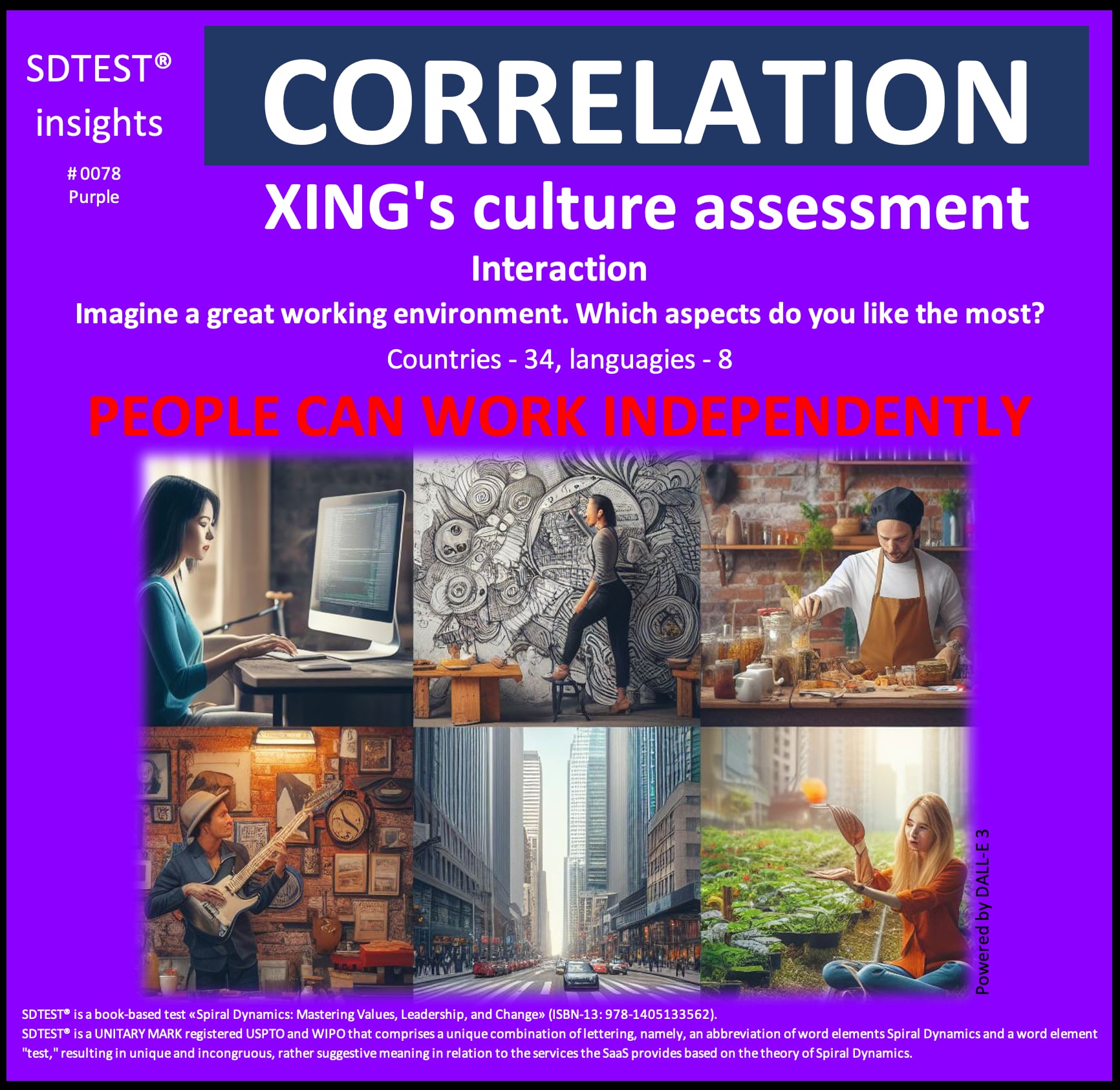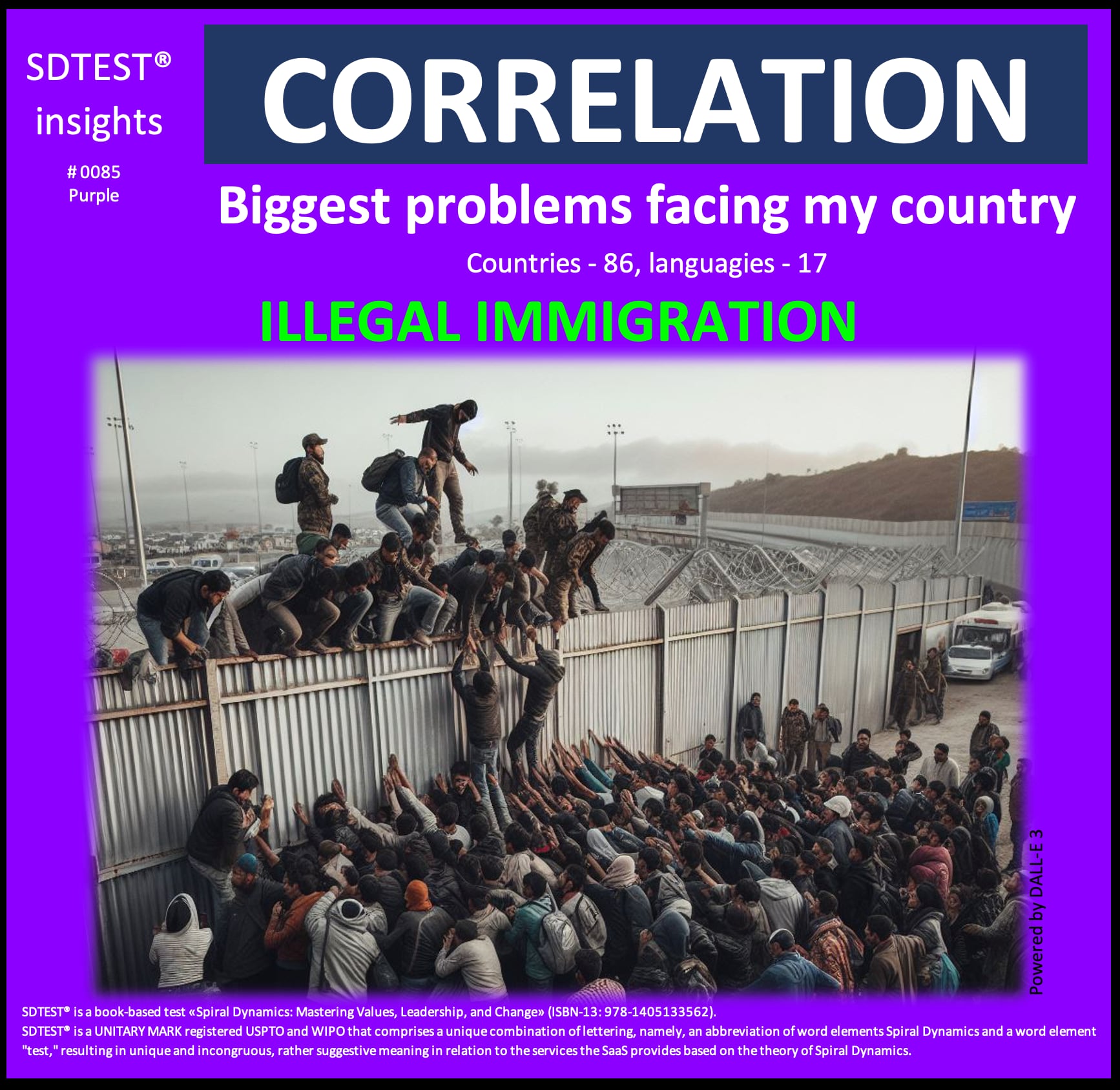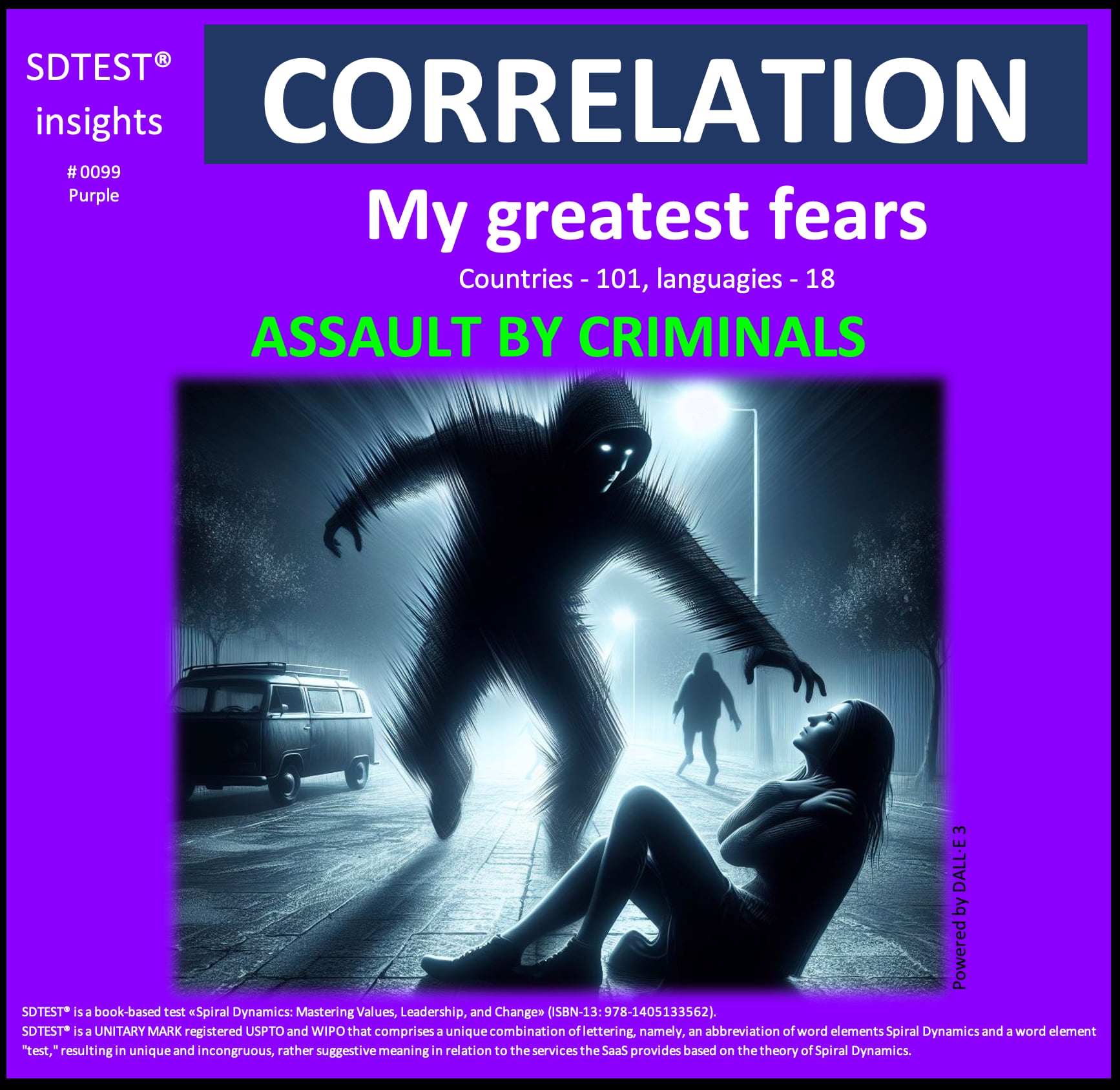Mastering Values, Leadership, and
Change» (ISBN-13: 978-1405133562)

| Color | In a life | In a business |
| Turquoise | The Global vision | Synthesis |
| Yellow | Flexible stream | Win-Win-Win behaviour |
| Green | Interpersonal relations | Social networks |
| Orange | Competition | Project management |
| Blue | The power of truth | Business Process Management |
| Red | The rule of force | Starting up a personal business |
| Purple | Family relations | Family relations |
| Beige | Survival | Own farm |
We invite curiosity about the systemic mechanisms behind this correlation. There may be hidden variables that provide alternative explanations.
-0.0526 between Adaptability to change and Purple stage.
The critical value of the correlation coefficient for a normal distribution, by William Sealy Gosset (Student) r = 0.0444. This negative correlation -0.0528 meets the reliability criteria but does not necessarily imply causation.

A key insight around this negative correlation is that the Purple vMeme's strong attachment to ancestral traditions and beliefs could restrict adaptability to change. As the statistical analysis shows, the more one associates with the Purple stage oriented around customary rituals and a tight-knit in-group identity, the less capacity they may have to adapt flexibly.
This makes intrinsic sense - groups guided strictly by "the way things have always been done" will likely resist shifts threatening tribal norms. However, the negative correlation provokes thought around nuances. Perhaps certain aspects of Purple values offer stability amidst change, even while limiting the willingness to reinvent.
Moving forward, we must carefully study how beliefs that "wisdom lies in the past" intersect with progressive adaptation. Under what circumstances might allegiance to tradition severely hamper versus moderately slow, flexible responses to shifting conditions? Are there tipping points where Purple psychology snaps from change-aversion to change-acceptance?
0.0931 between the Feel they have something to lose and the Purple stage.
The critical value of the correlation coefficient for a normal distribution, by William Sealy Gosset (Student) r = 0.0627. This positive correlation of 0.0931 meets the reliability criteria but does not necessarily imply causation.

This positive correlation of 0.0931 connects to the Purple value system's tight communal bonds and customary ways of life. When existence revolves around ancestral rituals and tribal belonging, shifts threatening these structures jeopardize one's very sense of meaning.
The prospect of exile from familiar patterns rightfully evokes fear. Without a spiritual community, Purple psychology loses all orientation. So reactions to guard against change emerge strongly; risk-taking is rare when transforms may upend all security.
We should only assume assumptions either way until examining this correlation rigorously across various situations. As with all developmental worldviews, Purple psychology contains multidimensionality worth unpacking! We'd like to hear more from you here.
We talked about this poll in more detail in this article.
0.0937 between the Is generally free of corruption / Agree strongly and the Purple stage.
The critical value of the correlation coefficient for a normal distribution, by William Sealy Gosset (Student) r = 0.0718. This positive correlation of 0.0937 meets the reliability criteria but does not necessarily imply causation.

This positive correlation of 0.0937 between a strong agreement that one's country is free of corruption and identification with the Purple vMeme reveals intriguing insights about traditional community psychology.
At first glance, the correlation seems counterintuitive - we may assume that hierarchical power dynamics of ancestral tribes would enable corrupt exploitation. However, within tightly knit Purple groups bonded by ritual and shared mythological beliefs, perhaps exploitation by leadership seems impossible.
Who is one to question if the chief or elder council holds god-like authority? And when survival depends intensely on group belonging, the thought of speaking out likely feels unfathomable. The correlation hints that corruption may only register once independence of thought and willingness to critique authority emerge in later vMemes.
0.0856 between The employees were sent on unpaid vacation and the Purple stage.
The critical value of the correlation coefficient for a normal distribution, by William Sealy Gosset (Student) r = 0.077. This positive correlation of 0.0856 meets the reliability criteria but does not necessarily imply causation.

This positive correlation of 0.0856 initially seems counterintuitive given the Purple value system's in-group solid loyalty and protection of shared resources for survival. However, it connects to a deeper deference to authority within customary communities.
If the chief or council decrees specific austerity measures in lean times, Purple psychology likely accepts this even at a high cost - their destinies intertwine with group continuity. Likewise, in organizations, those identifying with Purple submit to hardships if sanctified by higher-ups upholding more profound traditions tying social fabric.
However, bitterness can arise if belts tighten unfairly across the hierarchy. And if adversity persists too long without spiritual meaning, resignation may displace sacrifice.


This positive correlation of 0.0886 makes sense when we consider the significance of trust in the tightly-knit Purple worldview. In mystical, traditional communities, survival depends on cooperative reliance within the group and its chieftains.
Trust in leadership to provide stability and a connection to the divine allows Purple members to feel safe. Questioning the chief's credibility could unravel the carefully constructed walls protecting against chaos. Their trustworthiness proves that their values are intact.
So, for Purple, a leader seen as honest and dependable evidences greater forces blessing the social hierarchy. It enables continuity between generations and faith in a power larger than oneself. Trust transfers mystic legitimacy in a tangible way that perpetuates tribal bonds. This explains the correlation at purple's core.


0.1632 between the No and the Purple stage.
The critical value of the correlation coefficient for a normal distribution, by William Sealy Gosset (Student) r = 0.1125. This positive correlation of 0.1632 meets the reliability criteria but does not necessarily imply causation.

This positive correlation of 0.1632 indicates that the organization does not foster a collaborative culture. The positive correlation with the purple value system suggests that those aligned with purple values are more likely to view the competitive, individualistic culture negatively.
This makes sense, given Purple's emphasis on community, tradition, and group identity over individual interests. People guided by purple values may see an organizational culture that pits employees against each other in competition as detrimental to the collective good. It goes against their communitarian way of life.
Instead, those in the purple stage would likely advocate for a workplace that operates more like an extended family, with knowledge-sharing, cooperation, and care for the group's welfare. They want to feel part of something larger than themselves.
While healthy competition has its place, when taken too far, it can undermine social cohesion. This correlation reminds us that we should maintain our shared humanity in pursuing individual success. A sense of community is vital for human flourishing.
-0.1007 between the No, our organization has not systems in place to deal with cases of ageism and the Purple stage.
The critical value of the correlation coefficient for a normal distribution, by William Sealy Gosset (Student) r = 0.0861. This negative correlation of -0.1007 meets the reliability criteria but does not necessarily imply causation.

This negative correlation of -0.1007 suggests that organizations aligned with the Purple value system are more likely to have systems in place to deal with ageism. This makes sense, given Purple's emphasis on tradition, community, and respect for elders.
In Purple societies, age is often associated with wisdom and authority. The elderly are crucial in passing down ancestral knowledge and guiding the group. Disrespecting elders would violate core Purple values.
0.1130 between the I don't feel particularly healthy / Strongly Agree and the Purple stage.
The critical value of the correlation coefficient for a normal distribution, by William Sealy Gosset (Student) r = 0.0594. This positive correlation of 0.1130 meets the reliability criteria but does not necessarily imply causation.

This positive correlation of 0.1130 aligns with some key characteristics of the Purple value system. The Purple stage represents a strong focus on tradition, rituals, and adherence to the beliefs and ways of one's ancestors. Individuals in this stage are guided by myths, taboos, and a deep sense of belonging to their community or tribe.
One potential explanation for the observed correlation could be that individuals operating primarily from the Purple vMeme worldview may place greater emphasis on spiritual or supernatural beliefs related to health and well-being. These beliefs could influence their perception of their physical health status.
Additionally, the strong sense of community and adherence to traditional practices in the Purple stage could impact health-related behaviors and attitudes. This can sometimes lead to resistance or skepticism towards modern medical practices or interventions contradicting long-held cultural norms or beliefs regarding health and healing.
It is also possible that factors such as access to healthcare resources, socioeconomic status, or cultural beliefs about health and illness could contribute to the observed correlation, as these elements may be related to both perceived health status and the predominance of specific value systems within a given population.
Furthermore, as societies evolve and integrate different value systems, traditional beliefs and practices may adapt or coexist with modern medical knowledge and practices, leading to a more holistic approach to health and well-being.
-0.1933 between the People can work independently and the Purple stage.
The critical value of the correlation coefficient for a normal distribution, by William Sealy Gosset (Student) r = 0.1642. This negative correlation of -0.1933 meets the reliability criteria but does not necessarily imply causation.

In this negative correlation of -0.1933, the negative association could be explained by the Purple stage's emphasis on collectivism, group cohesion, and adherence to established norms and practices.
Individuals at the Purple stage may value working collaboratively within their community or tribe, following the guidance of elders or leaders, and adhering to traditional ways of doing things. Working independently may contradict this value system's strong sense of community and interdependence.
Additionally, the Purple vMeme's reliance on rituals, taboos, and established practices could contribute to a preference for more structured and prescribed working methods rather than valuing individual autonomy or independent decision-making.
The Purple value system is characterized by a strong focus on tradition and spirituality and a deep sense of community and belonging to a group. Individuals operating from this worldview are guided by myths, rituals, and the beliefs and laws of their ancestors. They have a strong sense of identity rooted in their collective and believe in influential, all-knowing leaders or deities.
0.0881 between the Illegal immigration and the Purple stage.
The critical value of the correlation coefficient for a normal distribution, by William Sealy Gosset (Student) r = 0.0525. This positive correlation of 0.0881 meets the reliability criteria but does not necessarily imply causation.

This positive correlation of 0.0881 exceeds the critical value of 0.0525 and meets the reliability criteria for further examination. The Purple value system emphasizes tradition, spirituality, and a deep sense of belonging to a group or community.
In the context of this correlation, the perception of "Illegal immigration" as a significant problem could resonate with Purple vMeme's emphasis on preserving traditional ways of life, maintaining a cohesive sense of community, and protecting one's group's established norms and practices.
Individuals at the Purple stage may view illegal immigration as a potential threat to the cultural and social fabric of their community, as well as a challenge to the established order and traditions that have been passed down through generations.
Additionally, the Purple value system's reliance on rituals, taboos, and strict adherence to group norms could contribute to a perception that illegal immigration represents a deviation from the accepted rules and boundaries that define the in-group and out-group dynamics.

0.0756 between the Assault by criminals and the Purple stage.
The critical value of the correlation coefficient for a normal distribution, by William Sealy Gosset (Student) r = 0.0359. This positive correlation of 0.0756 meets the reliability criteria but does not necessarily imply causation.

This positive correlation of 0.0756 suggests a relationship between the fear of assault by criminals and individuals operating within the Purple stage of value system development. Specifically, those aligned with the Purple worldview tend to exhibit a higher association with expressing fear related to criminal assault.
From the lens of the Purple value system, this correlation reflects a deeply rooted sense of tradition and community and the importance of maintaining established norms and rituals. In traditional agricultural societies associated with the Purple stage, the sanctity of the community and the preservation of customs and beliefs are of the utmost importance.
It is important to note that this positive correlation does not necessarily imply an irrational or excessive fear within the Purple value system. Instead, it may reflect a deep-rooted cultural and societal context in which the preservation of community, adherence to traditions, and maintaining order are highly valued.
The fear of assault by criminals may stem from a perception that such acts not only threaten individual safety but also disrupt the harmony and cohesion of the community as a whole. Within the Purple worldview, criminal behavior could be seen as a violation of the sacred traditions, rituals, and taboos that govern the collective.
-0.0794 between the Psychological safety and the Purple stage.
The critical value of the correlation coefficient for a normal distribution, by William Sealy Gosset (Student) r = 0.061. This negative correlation of -0.0794 meets the reliability criteria but does not necessarily imply causation.

This negative correlation of -0.0794 suggests an inverse relationship between the perception of psychological safety as a factor impacting team effectiveness and individuals operating within the Purple stage of value system development. Specifically, those aligned with the Purple worldview tend to exhibit a lower association with acknowledging psychological safety as a critical factor for team effectiveness.
Within the Purple worldview, psychological safety, which involves feeling comfortable expressing oneself without fear of negative consequences or judgment, may be perceived as secondary to maintaining community cohesion, respecting traditions, and obeying the guidance of influential leaders or spiritual figures.
Moreover, the Purple value system is characterized by a strong sense of identity derived from belonging to a group and upholding the laws and beliefs of ancestors. The concept of psychological safety, emphasizing individual expression and openness, may be disruptive to the established order and collective identity.
However, it is essential to note that this negative correlation does not necessarily imply a complete disregard for individuals' well-being or psychological safety within the Purple value system. Instead, it may reflect a different understanding and prioritization of factors contributing to team effectiveness rooted in traditional agricultural societies' cultural and societal context.
0.1405 between the Sent employees on unpaid vacations and the Purple stage.
The critical value of the correlation coefficient for a normal distribution, by William Sealy Gosset (Student) r = 0.0572. This positive correlation of 0.1405 meets the reliability criteria but does not necessarily imply causation.

This positive correlation of 0.1405 could be explained from the perspectives of companies and individuals operating within the Purple value system, which emphasizes tradition, spirituality, belief in the supernatural, and a strong sense of community and belonging.
1) From the perspective of companies operating within the Purple value system:
This positive correlation suggests a relationship between companies aligned with the Purple worldview and the decision to send employees on unpaid vacations. Such companies may perceive this action as a necessary sacrifice for the greater good of the collective, in line with the Purple value system's emphasis on maintaining harmony and respecting the wisdom of influential leaders or elders. Sending employees on unpaid vacations is a way to uphold traditions and preserve the established order, even in challenging circumstances.
2) From the perspective of individuals within the Purple value system:
This positive correlation indicates a higher association between individuals operating within the Purple stage of value system development and their acceptance or tolerance of companies sending employees on unpaid vacations. For these individuals, rooted in traditional agricultural societies, the community's collective well-being and preserving established customs and practices are paramount. The decision to send employees on unpaid vacations may be perceived as a necessary sacrifice for the greater good, aligning with the Purple value system's emphasis on maintaining harmony and respect for the guidance of influential leaders or higher authorities.
It is important to note that this positive correlation does not necessarily imply an endorsement or approval of sending employees on unpaid vacations within the Purple value system. Instead, it may reflect an acceptance or a more fatalistic attitude towards such decisions, stemming from the belief in the community's collective well-being and the adherence to the laws and beliefs of ancestors.
In addressing issues related to personnel management, labor practices, and the intersection of cultural traditions and modern business practices, it may be beneficial for both companies and individuals to incorporate elements of the Purple value system, such as promoting a sense of community, respecting traditions and spiritual beliefs, and acknowledging the guidance of influential leaders or elders. By recognizing and accommodating these deeply ingrained values, organizations and societies can foster an environment that balances preserving cultural identity with pursuing sustainable and ethical business practices while respecting the perspectives and beliefs of individuals within the Purple value system.
What insights do you gain from these correlations?
We welcome respectful and wise perspectives!
After login or registration, free access to the poll results in the FAQ section.
